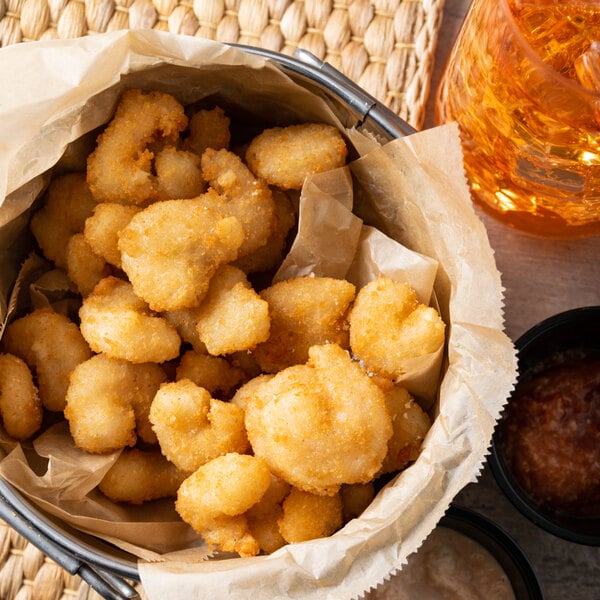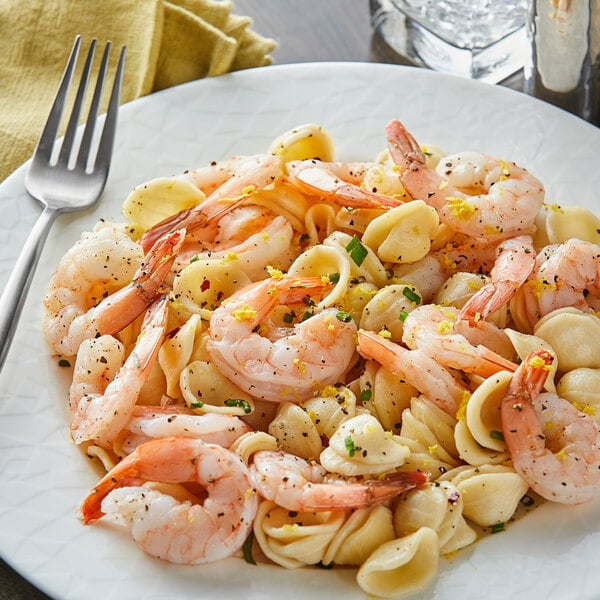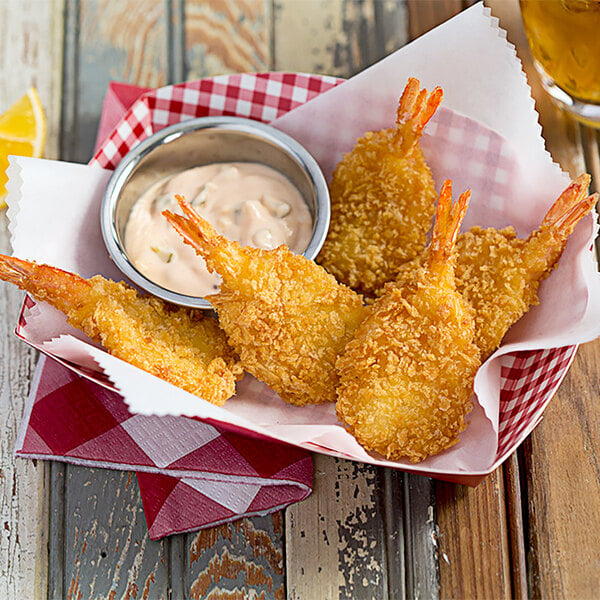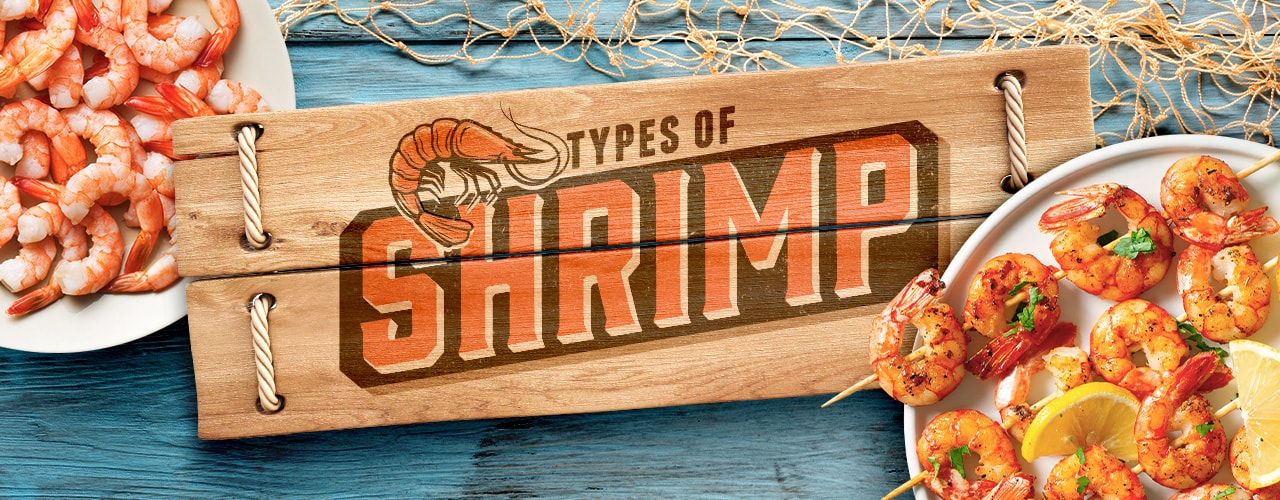Shrimp is a common food in the United States, and is one of the best seafood options for patrons to enjoy. While the food may not seem versatile on the surface, there are many different types and sizes of shrimp, each with its own unique features and flavor profiles. Understanding each type of shrimp and how it’s used will allow you to get the most out of your seafood recipes. We’ve created a guide to cover some of the most common types and sizes of shrimp you’ll encounter, as well as how you can utilize each in your establishment.
Shop All Shrimp- 1. Tiny Shrimp
- 2. Extra Small Shrimp
- 3. Small Shrimp
- 4. Medium Shrimp
- 5. Large Shrimp
- 6. Extra Large Shrimp
- 7. Jumbo Shrimp
- 8. Extra Jumbo Shrimp
- 9. Colossal Shrimp
- 10. Super Colossal Shrimp
- 11. Extra Colossal Shrimp
- 12. Rock Shrimp
- 13. Tiger Shrimp
- 14. White Shrimp
- 15. Pink Shrimp
- 16. Royal Red Shrimp
Shrimp Sizes
In addition to the different types of shrimp, there are also many different sizes of shrimp to consider. Shrimp sizes are determined by how many shrimp are in a pound. These sizes can range from as much as over 70 shrimp per pound all the way down to less than 10 shrimp per pound. Below we’ve listed the most common shrimp sizes, detailing how many shrimp you can expect per pound for each size and how each size should be prepared.

1. Tiny Shrimp
The mini-size of tiny shrimp makes them perfect for foods such as soups and gumbos. Tiny shrimp are also easy to grind, making them a good candidate for pastes and fillings. Due to their small size, this type is usually only sold peeled and deveined. As a result, prep time is greatly reduced.
- Tiny Shrimp Per Pound - Over 70
- Tiny Shrimp Per 3 oz. Serving - Between 13 and 19

2. Extra Small Shrimp
Extra small shrimp are larger than tiny shrimp, but they are still bite-sized. Just like with tiny shrimp, this size of shrimp is a fantastic way to add protein to dishes like salads and soups. Extra small shrimp is also great in seafood pasta, adding some extra flavor without dominating the overall taste.
- Extra Small Shrimp Per Pound - Between 71 and 90
- Extra Small Shrimp Per 3 oz. Serving - Between 14 and 16

3. Small Shrimp
Small shrimp are the perfect size for appetizers and a slew of great recipes, making them one of the most common sizes of shrimp. Like most of the smaller types of shrimp, small shrimp has a sweet, mild flavor. This type is most commonly used in dishes like shrimp scampi, shrimp tacos, and seafood chowder.
- Small Shrimp Per Pound - Between 51 and 60
- Small Shrimp Per 3 oz. Serving - Between 12 and 14

4. Medium Shrimp
While not as minuscule as small or tiny varieties, medium shrimp are still on the smaller side of sizes. Medium shrimp’s mild taste blends well with a variety of ingredients making it a versatile food that can be added to several different dishes. This size is perfect for creating dishes like shrimp fried rice, shrimp scampi, and shrimp creole.
- Medium Shrimp Per Pound - Between 38 and 50
- Medium Shrimp Per 3 oz. Serving - Between 9 and 12

5. Large Shrimp
Large shrimp pack a bit more flavor than smaller varieties and are big enough to sear and grill independently. Large shrimp is a good happy medium between the sweetness of smaller shrimp sizes and the strong flavors of larger shrimp varieties. This type of shrimp is often used as a protein option in salads and grain bowls and is a great inclusion when making spring rolls and stir-fries.
- Large Shrimp Per Pound - Between 31 and 40
- Large Shrimp Per 3 oz. Serving - Between 8 and 10

6. Extra Large Shrimp
Extra Large shrimp are an excellent size to serve on their own as an appetizer or a light entree. This type is fantastic for catered events and banquet halls, as you can pair them with your signature cocktail sauce and construct a delicious seafood platter. As an ingredient, extra large shrimp are great in recipes like seafood risotto and pasta.
- Extra Large Shrimp Per Pound - Between 26 and 30
- Extra Large Shrimp Per 3 oz. Serving - Between 7 and 8

7. Jumbo Shrimp
Jumbo shrimp are among the most common sizes of shrimp, being used in a variety of recipes and dishes. This size of shrimp has a sweet flavor paired with a strong crunchy texture, making them the perfect size for shrimp cocktails. Since jumbo shrimp are so common, you can serve them in several different ways. Some of the most common uses are appetizers like shrimp skewers or as a topping for dishes like seafood pizza.
- Jumbo Shrimp Per Pound - Between 21 and 25
- Jumbo Shrimp Per 3 oz. Serving - Between 5 and 7

8. Extra Jumbo Shrimp
Coming in slightly larger than jumbo shrimp, the extra jumbo variety is the perfect size for finger food appetizers such as the Spanish tapa gambas al ajillo. You’ll commonly find extra jumbo shrimp on various seafood platters, making them a strong choice for catered events. Some of the most common ways of preparing extra jumbo shrimp include appetizers like fried coconut shrimp and grilled shrimp skewers.
- Extra Jumbo Shrimp Per Pound - Between 16 and 20
- Extra Jumbo Shrimp Per 3 oz. Serving - 4 or 5

9. Colossal Shrimp
Colossal shrimp are known for their strong and succulent flavor. The flavor profile of colossal shrimp paired with their large size makes them one of the best sizes of shrimp to grill and sear. Colossal shrimp are large enough to be their own main course, so some common uses include stuffed shrimp and breaded shrimp.
- Colossal Shrimp Per Pound - Under 15
- Colossal Shrimp Per 3 oz. Serving - 3 or 4

10. Super Colossal Shrimp
Super colossal shrimp are among the biggest sizes of shrimp, being almost twice the size of jumbo shrimp. Due to their massive size, super colossal shrimp are typically only used in restaurants. This type of shrimp is popular for its strong flavor and crispiness, as it’s often compared to other seafood dishes like lobster.
- Super Colossal Shrimp Per Pound - Under 12
- Super Colossal Shrimp Per 3 oz. Serving - 2 or 3

11. Extra Colossal Shrimp
Extra colossal shrimp are the largest size of shrimp you can use, making them quite rare. Since smaller sizes like jumbo and colossal shrimp are large enough to stand as a main course, some feel that extra colossal shrimp can be too large. When prepared, this type of shrimp is usually grilled and stuffed with another form of seafood such as crab.
- Extra Colossal Shrimp Per Pound - Under 10
- Extra Colossal Shrimp Per 3 oz. Serving - 2 or 3
Shrimp Types
While there are over 300 different edible species of shrimp in the world, you’ll only find a handful of different types being used in recipes. Still, these different types of shrimp can vary greatly, as some have mild flavors and delicate textures while others have bold and briny flavors. Not only do these types pair differently with other foods, but they are also cooked and prepared differently as well. We’ll cover some of the most important types of shrimp, allowing you to elevate your seafood dishes to the next level.

Rock Shrimp
Rock shrimp are named for their rock-hard shells, although they are typically deshelled before being sold. This type of shrimp tends to be smaller, usually only a few inches in length. Rock shrimp’s flavor profile is similar to that of lobster, and it is often used in seafood dishes as a less expensive alternative to lobster meat. For this reason, rock shrimp can be used in a slew of different recipes, but are most commonly fried for dishes such as tempura or popcorn shrimp.

Tiger Shrimp
When cooked, this type of shrimp has a striped pattern on its back, giving tiger shrimp its name. Tiger shrimp is one of the larger types of shrimp, providing a lot of meat for use. This type of shrimp has a mild taste, meaning it's best paired with foods or toppings with strong flavors. As a result, you’ll find tiger shrimp used in recipes like shrimp cocktails, or in mixed seafood dishes like scampi or paellas.

White Shrimp
White shrimp are small warm-water shrimp native to the East Coast of the United States, turning from a translucent color to white when cooked. Warm-water varieties like white shrimp are known for their ability to absorb flavors from sauces and seasonings. As a result, this type of shrimp is great in tandem with barbeque and curry sauces. You’ll find white shrimp being used in dishes like gumbo and shrimp creole as well.

Pink Shrimp
Pink shrimp get their name from their pinkish color when raw. This type of shrimp is similar to white shrimp, and the two are sometimes used interchangeably. However, pink shrimp are often larger and sweeter than other warm-water shrimps. Due to their large size and sweet taste, pink shrimp is one of the best options to include in a seafood boil.

Royal Red Shrimp
Royal red shrimp are among the most sought-after type of shrimp, as they are known for their tenderness and delicious, salty flavor. These shrimp are extremely popular, often being compared to bay scallops in terms of taste. Royal red's strong and buttery flavor lends itself perfectly to a variety of recipes, but they can commonly be found in risotto and shrimp and grits. Alternatively, royal red shrimp can be served as its own main course with a side of melted butter, highlighting the food's delicious flavor and tender texture.
Back to TopDifferent types and sizes of shrimp have different flavor profiles and uses, making it key for restaurant operators to understand the difference. Knowing the different types and sizes of shrimp makes it easier to include the food in recipes, greatly enhancing a dish. Failure to understand the different types of shrimp can lead to unbalanced portions and unpleasant flavor profiles. Any restaurant operator planning to use shrimp and other seafood in their menu should be well aware of the different types and sizes and how each should be used.



